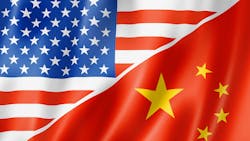David Autor and David Dorn are two human wrecking balls smashing the edifice of economics consensus. For decades, the one big thing economists could agree on was that free trade, on balance, was good for the U.S. economy. Now, in a series of papers with a variety of co-authors, Autor and Dorn have shown that the dramatic increase in U.S. trade with China in the 2000s was a different and far more destructive beast -- a phenomenon commonly called the China Shock.
The first of these papers showed that the China Shock left deep and lasting scars on huge swathes of the American workforce. The second demonstrated that the China Shock increased political polarization. Now, together with Gordon Hanson, Pian Shu, and Gary Pisano, the wrecking-ball duo have a third paper, showing that the China Shock decreased U.S. corporate innovation.
For a long time, the consensus had been that foreign competition makes companies in rich countries invest more in innovation. There are at least three reasons why this would be the case. First, intensified competition forces industry leaders to spend more on research and development if they want to stay ahead of rivals in the long run. Second, competition that forces companies to scale back production leaves these firms with unused resources, which they might as well use for innovative activities. This is called the trapped factor effect. The third reason is that more trade means larger markets, which increases the potential payoff from creating new products -- as an example, witness how much money Apple Inc. has made from overseas sales of iPhones.
However, there are also reasons why increased overseas competition might reduce innovation. Companies whose profit margins are safe can afford to plow some of their profits back into future-oriented activity like research. But when they come under threat from rivals, they may have to cut back on this investment in order to survive. Economists have known about this possibility for a long time, but have generally discounted it in favor of the more optimistic theories.
For a while, the evidence on competition and innovation seemed to favor the optimists. A study by economists Nicholas Bloom, Mirko Draca and John van Reenen looked at the effect of Chinese import competition on European companies’ innovation from 1996 through 2007. They found that when the European Union lifted quotas on a product after China’s 2001 entry into the World Trade Organization, European companies making that product increased their patenting activity, spent more on R&D and used more information technology.
Versions of that paper have been circulating for about five years now, and economists and pundits -- including Yours Truly -- often used it to argue that free trade would boost innovation. But as it turned out, Bloom et al. didn't have the last word on the matter.
Autor et al. conducted a similar analysis in the U.S., and found much different results. Instead of regulatory changes, they base their analysis on which Chinese export industries were growing strongly at the time, and examine how U.S. manufacturing companies in the same industries responded to the surge.
They found that American companies that came under intensified Chinese competition scaled back all types of business activity, including R&D. They also reduced their patenting activity, both at home and overseas.
This is exactly the opposite of what Bloom et al. found. Why the difference? One possibility is that the U.S. and Europe are just very different. European markets might be more protected, and hence companies might have extra resources that they can reallocate to innovation in the event of increased competition -- the trapped factor effect. Competitive American companies, on the other hand, might already be operating on the knife edge of profitability, and hence might simply have to shrink when challenged by the Chinese. Also, unlike their U.S. counterparts, European manufacturers tend to export a lot to China, so increased Chinese imports might have been balanced by higher export demand. The differences could also stem from the fact that Autor et al. use a longer time period and a larger sample of industries, and try to correct for existing time trends in different industries.
The two papers also use different methods to determine how much imports increased over baseline after China joined the WTO. Bloom et al. look at industries where product quotas were lifted -- these industries might just be more protected than others, and hence better able to spend money on research when confronted with competition. Meanwhile, Autor et al. look at industries where China started exporting more all over the world -- these industries might be more productive and competitive than others, which could make rich-country competitors more likely to throw in the towel.
Additional research is needed to determine whether Autor et al. or Bloom et al. have it right. But the mere existence of the Autor et al. result challenges one of the pillars holding up the case for free trade. No longer can we confidently assume that U.S. companies will innovate to stay ahead of global competition. Once again, the China Shock has thrown economists’ comfortable consensus into doubt.
by Noah Smith
